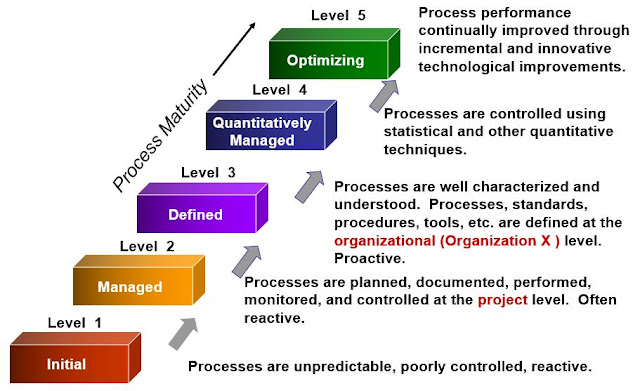Lets Start a Company with CMMI Level
A maturity level is a well-defined evolutionary plateau
toward achieving a mature software process. Each maturity level provides a
layer in the foundation for continuous process improvement.
In CMMI models with a
staged representation, there are five maturity levels designated by the numbers
1 through 5
1. Initial
2. Managed
3. Defined
4. Quantitatively
Managed
5. Optimizing
Maturity Level
Details:
Maturity levels consist of a predefined set of process
areas. The CMMI levels are measured by the achievement of the specific and
generic goals that apply to each predefined set of process areas.
To start with we will
only talk about first two levels in details :-
Maturity Level 1 - Initial
At maturity level 1, processes are usually ad hoc and
chaotic. The organization usually does not provide a stable environment.
Success in these organizations depends on the competence and heroics of the
people in the organization and not on the use of proven processes.
Maturity level 1 organizations often produce products and
services that work; however, they frequently exceed the budget and schedule of
their projects.
Maturity level 1 organizations are characterized by a
tendency to over commit, abandon processes in the time of crisis, and not be
able to repeat their past successes.
Maturity Level 2 -
Managed
At maturity level 2, an organization has achieved all the
specific and generic goals of the maturity level 2 process areas. In other
words, the projects of the organization have ensured that requirements are
managed and that processes are planned, performed, measured, and controlled.
The process discipline reflected by maturity level 2 helps
to ensure that existing practices are retained during times of stress. When
these practices are in place, projects are performed and managed according to
their documented plans.
At maturity level 2, requirements, processes, work products,
and services are managed. The status of the work products and the delivery of
services are visible to management at defined points. Commitments are established among relevant stakeholders and
are revised as needed. Work products are reviewed with stakeholders and are
controlled.
The work products and services satisfy their specified
requirements, standards, and objectives.
Visit our website: Indicium Assessment














1 comments:
Write comments
ReplyThank you for your information.
CMMI Consulting india - AmitySoft